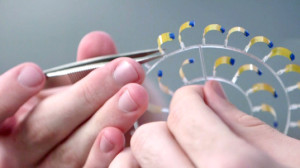
Scientist from Columbia University has developed two engines that can generate green electricity from evaporation water. This clean renewable energy source could help to power robots, sensors or any other small devices. It is already known from biology that redwood trees rely on evaporation to pull water from the ground to their crowns, into a so called pumping by vacuum effect or the osmotic process. This way the evaporation can be a source of green electricity.
In a first step of the project, the researchers found that when bacterial spores expand and shrink with changing humidity, they could push and pull objects very forcefully. They built a piston-driven engine by gluing a dashed line of spores one the side of a thin, double sided plastic tape. On the other side of the tape they had already put an identically dashed line of spores but offset the spores so dashes on one side overlapped with gaps on the other. This way when the air is dry, the tape curves, and when it is moist, it extends. They called the system “hygroscopy driven artificial muscles” or HYDRAs.

Then in the further experiments they placed dozens of spore covered tapes side by side in a case filled party with water. This humidity made the artificial muscles expand to open the shutters and then the air dry out. With the humidity getting out, the artificial muscles shrunk to close the shutters and evaporating water restarted the cycle of motion. This way the evaporation driven piston generated enough green electricity to make a small LED to flash.
Another evaporation driven rotary engine was built having two half of exposed spores. Half of them sat in dry air causing the tabs to curve and the other half sat in moist air and make the tabs straighten. The good result was that wheel rotated continuously enough green electricity to power a small toy car weighting 100 g.
By this project HYDRAs the researchers appreciated that larger versions of evaporation – driven rotary engines placed above large bodies of water could steadily produce more green electricity than wind farms. This could drive to future next studies and always is time for improvement.



